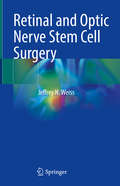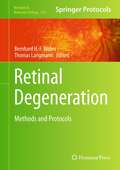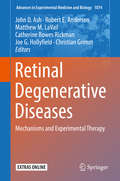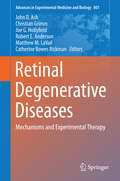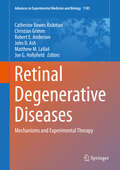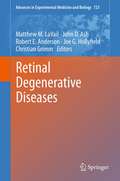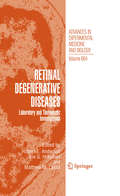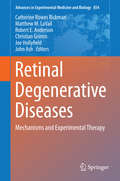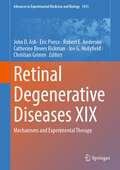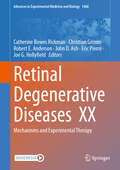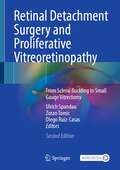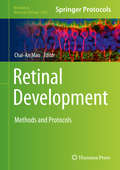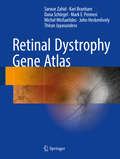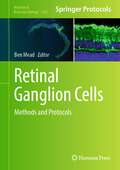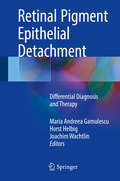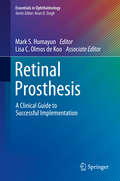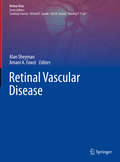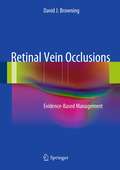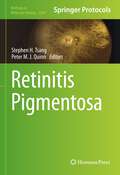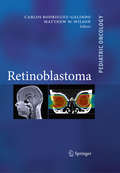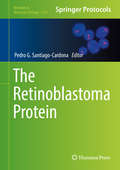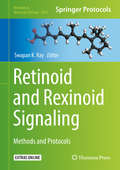- Table View
- List View
Retinal and Optic Nerve Stem Cell Surgery
by Jeffrey N. WeissThis is a concise how-to of successfully treating previously deemed "untreatable" retinal and optic nerve conditions with stem cell therapies. Based on the results of 11 years of experience treating approximately 600 patients, this text will serve as a template for others to develop similar stem cell based treatments in their specialty. Author, Jeffrey N. Weiss, MD is specifically poised to offer dependable insight on stem cell surgery for both the retina and the optic nerve, having performed the first retinal stem cell surgery in 2010, with Institutional Review Board (IRB) approved studies that are registered with the National Institute of Health (NIH), and listed on ClinicalTrials.gov. Featuring all original work from Dr. Jeffrey Weiss's specialization in stem cell ophthalmology, this book is primarily written for ophthalmologists, but structured so that specialists across disciplines can take the model presented and create their own studies and clinical trials using stem cell therapies.
Retinal Degeneration
by Bernhard H.F. Weber Thomas LangmannOver the past decades, knowledge about the cellular and molecular basis underlying the visual process has remarkably increased. In Retinal Degeneration: Methods and Protocols, expert researchers in the field provide a guide of relevant and state-of-the-art methods for studying retinal homeostasis and disease. These include methods and techniques for addressing cell culture systems and animal models of disease, their generation, their phenotypic and molecular characterization as well as their use in therapeutic approaches to the retina. Written in the highly successful Methods in Molecular BiologyTM series format, chapters include introductions to their respective topics, lists of the necessary materials and reagents, step-by-step, readily reproducible laboratory protocols, and key tips on troubleshooting and avoiding known pitfalls. Authoritative and practical, Retinal Degeneration: Methods and Protocols aids scientists in continuing to study the cutting-edge techniques of retinal cell biology in health and disease.
Retinal Degenerative Diseases: Laboratory And Therapeutic Investigations (Advances In Experimental Medicine And Biology #723)
by John D. Ash Robert E. Anderson Matthew M. LaVail Catherine Bowes Rickman Joe G. Hollyfield Christian GrimmThe blinding diseases of inherited retinal degenerations have no treatments, and age-related macular degeneration has no cures, despite the fact that it is an epidemic among the elderly, with 1 in 3-4 affected by the age of 70. The RD Symposium will focus on the exciting new developments aimed at understanding these diseases and providing therapies for them. Since most major scientists in the field of retinal degenerations attend the biennial RD Symposia, they are known by most as the “best” and “most important” meetings in the field. The volume will present representative state-of-the-art research in almost all areas of retinal degenerations, ranging from cytopathologic, physiologic, diagnostic and clinical aspects; animal models; mechanisms of cell death; candidate genes, cloning, mapping and other aspects of molecular genetics; and developing potential therapeutic measures such as gene therapy and neuroprotective agents for potential pharmaceutical therapy. While advances in these areas of retinal degenerations will be described, there will be many new topics that either were in their infancy or did not exist at the time of the last RD Symposium, RD2014. These include the role of inflammation and immunity, as well as other basic mechanisms, in age-related macular degeneration, several new aspects of gene therapy, and revolutionary new imaging and functional testing that will have a huge impact on the diagnosis and following the course of retinal degenerations, as well as to provide new quantitative endpoints for clinical trials. The retina is an approachable part of the central nervous system (CNS), and there is a major interest in neuroprotective and gene therapy for CNS diseases and neurodegenerations, in general. It should be noted that with successful and exciting initial clinical trials in neuroprotective and gene therapy, including the restoration of sight in blind children, the retinal degeneration therapies are leading the way towards new therapeutic measures for neurodegenerations of the CNS. Many of the successes recently reported in these areas of retinal degeneration sprang from collaborations established at previous RD Symposia, and many of those will be reported at the RD2018 meeting and included in the proposed volume. We anticipate the excitement of those working in the field and those afflicted with retinal degenerations will be reflected in the volume.
Retinal Degenerative Diseases
by John D. Ash Christian Grimm Joe G. Hollyfield Robert E. Anderson Matthew M. Lavail Catherine Bowes RickmanThis book will contain the proceedings of the XV International Symposium on Retinal Degeneration (RD2012). A majority of those who will speak and present posters at the meeting will contribute to this volume. The blinding diseases of inherited retinal degenerations have no treatments, and age-related macular degeneration has no cures, despite the fact that it is an epidemic among the elderly, with 1 in 3-4 affected by the age of 70. The RD Symposium will focus on the exciting new developments aimed at understanding these diseases and providing therapies for them. Since most major scientists in the field of retinal degenerations attend the biennial RD Symposia, they are known by most as the "best" and "most important" meetings in the field. The volume will present representative state-of-the-art research in almost all areas of retinal degenerations, ranging from cytopathologic, physiologic, diagnostic and clinical aspects; animal models; mechanisms of cell death; candidate genes, cloning, mapping and other aspects of molecular genetics; and developing potential therapeutic measures such as gene therapy and neuroprotective agents for potential pharmaceutical therapy. While advances in these areas of retinal degenerations will be described, there will be many new topics that either were in their infancy or did not exist at the time of the last RD Symposium, RD2010. These include the role of inflammation and immunity, as well as other basic mechanisms, in age-related macular degeneration, several new aspects of gene therapy, and revolutionary new imaging and functional testing that will have a huge impact on the diagnosis and following the course of retinal degenerations, as well as to provide new quantitative endpoints for clinical trials. The retina is an approachable part of the central nervous system (CNS), and there is a major interest in neuroprotective and gene therapy for CNS diseases and neurodegenerations, in general. It should be noted that with successful and exciting initial clinical trials in neuroprotective and gene therapy, including the restoration of sight in blind children, the retinal degeneration therapies are leading the way towards new therapeutic measures for neurodegenerations of the CNS. Many of the successes recently reported in these areas of retinal degeneration sprang from collaborations established at previous RD Symposia, and many of those will be reported at the RD2010 meeting and included in the proposed volume. We anticipate the excitement of those working in the field and those afflicted with retinal degenerations will be reflected in the volume.
Retinal Degenerative Diseases: Mechanisms and Experimental Therapy (Advances in Experimental Medicine and Biology #1185)
by Joe G. Hollyfield Robert E. Anderson Christian Grimm John D. Ash Catherine Bowes Rickman Matthew M. LaVailThis book contains the proceedings of the XVIII International Symposium on Retinal Degeneration (RD2018). A majority of those who spoke and presented posters at the meeting contributed to this volume. The blinding diseases of inherited retinal degenerations have no treatments, and age-related macular degeneration has no cures, despite the fact that it is an epidemic among the elderly, with 1 in 3-4 affected by the age of 70. The RD Symposium focused on the exciting new developments aimed at understanding these diseases and providing therapies for them. Since most major scientists in the field of retinal degenerations attend the biennial RD Symposia, they are known by most as the “best” and “most important” meetings in the field. The volume presents representative state-of-the-art research in almost all areas of retinal degenerations, ranging from cytopathologic, physiologic, diagnostic and clinical aspects; animal models; mechanisms of cell death; candidate genes, cloning, mapping and other aspects of molecular genetics; and developing potential therapeutic measures such as gene therapy and neuroprotective agents for potential pharmaceutical therapy. While advances in these areas of retinal degenerations were described, there will be many new topics that either are in their infancy or did not exist at the time of the last RD Symposium, RD2016. These include the role of inflammation and immunity, as well as other basic mechanisms, in age-related macular degeneration, several new aspects of gene therapy, and revolutionary new imaging and functional testing that will have a huge impact on the diagnosis and following the course of retinal degenerations, as well as to provide new quantitative endpoints for clinical trials. The retina is an approachable part of the central nervous system (CNS), and there is a major interest in neuroprotective and gene therapy for CNS diseases and neurodegenerations, in general. It should be noted that with successful and exciting initial clinical trials in neuroprotective and gene therapy, including the restoration of sight in blind children, the retinal degeneration therapies are leading the way towards new therapeutic measures for neurodegenerations of the CNS. Many of the successes recently reported in these areas of retinal degeneration sprang from collaborations established at previous RD Symposia, and many of those were reported at the RD2016 meeting and included in the current volume. We anticipate the excitement of those working in the field and those afflicted with retinal degenerations is reflected in the volume.
Retinal Degenerative Diseases
by Matthew M. Lavail Robert E. Anderson Joe G. Hollyfield Christian Grimm John AshThis book will contain the proceedings of the XIV International Symposium on Retinal Degeneration (RD2010), held July 13-17, 2010, in Mont-Tremblant, Quebec, Canada. The volume will present representative state-of-the-art research in almost all areas of retinal degenerations, ranging from cytopathologic, physiologic, diagnostic and clinical aspects; animal models; mechanisms of cell death; candidate genes, cloning, mapping and other aspects of molecular genetics; and developing potential therapeutic measures such as gene therapy and neuroprotective agents for potential pharmaceutical therapy.
Retinal Degenerative Diseases
by Matthew M. Lavail Joe G. Hollyfield Robert E. AndersonThis is the proceedings of the XIIIth International Symposium on Retinal Degenerations, which will be held in Emeishan, Sichuan, China on September 18 - 23, 2008. The themes will include "Molecular and genetic mechanisms in photoreceptor degeneration", "Age-related macular degeneration", "New diagnostic techniques for retinal degenerations". "Neuroprotection in the prevention of retinal degeneration", "Gene therapy and the correction of gene defects", as well as other emerging topics that may develop over the next few months.
Retinal Degenerative Diseases
by Catherine Bowes Rickman Matthew M. Lavail Robert E. Anderson Christian Grimm Joe Hollyfield John AshContains the proceedings of the XVI International Symposium on Retinal Degeneration (RD2014), to be held July 13-18, 2014 at the Asilomar Conference Center in Pacific Grove, California. A majority of those who will speak and present posters at the meeting will contribute to this volume. The Symposium addresses the blinding diseases of inherited retinal degenerations, which have no effective treatments and age-related macular degeneration, which has no cures, despite the fact that it is an epidemic among the elderly, with 1 in 3-4 affected by the age of 75. The RD2014 Symposium will focus on the exciting new developments aimed at understanding these diseases and providing therapies for them. The volume will present representative state-of-the-art research in almost all areas of retinal degenerations, ranging from cytopathologic, physiologic, diagnostic and clinical aspects; animal models; mechanisms of cell death; molecular genetics; and developing potential therapeutic measures such as gene therapy and neuroprotective agents for potential pharmaceutical therapy; and several sight restoration approaches, including optogenetics. While advances in these areas of retinal degenerations will be included, several new topics either were in their infancy or did not exist at the time of the last RD Symposium, RD2012. These include many new developments in sight restoration using optogenetics, retinal or RPE cell transplantation, stem cell approaches and visual prosthetic devices. In addition, major advances will be presented in other basic mechanisms in age-related macular degeneration, several new aspects of gene and antioxidant therapy and revolutionary new imaging and functional testing that will have a huge impact on the diagnosis and following the course of retinal degenerations, as well as to provide new quantitative endpoints for clinical trials. The retina is an approachable part of the central nervous system (CNS), and there is a major interest in neuroprotective and gene therapy for CNS diseases and neurodegenerations, in general. It should be noted that with successful and exciting initial clinical trials in neuroprotective and gene therapy, including the restoration of sight in blind children, the retinal degeneration therapies are leading the way towards new therapeutic measures for neurodegenerations of the CNS. Many of the successes recently reported in these areas of retinal degeneration sprang from collaborations established at previous RD Symposia, and many of those will be reported at the RD2014 meeting and included.
Retinal Degenerative Diseases XIX: Mechanisms and Experimental Therapy (Advances in Experimental Medicine and Biology #1415)
by Joe G. Hollyfield Robert E. Anderson Christian Grimm John D. Ash Catherine Bowes Rickman Eric PierceThis book contains the proceedings of the XVIII International Symposium on Retinal Degeneration (RD2018). A majority of those who spoke and presented posters at the meeting contributed to this volume. The blinding diseases of inherited retinal degenerations have no treatments, and age-related macular degeneration has no cures, despite the fact that it is an epidemic among the elderly, with 1 in 3-4 affected by the age of 70. The RD Symposium focused on the exciting new developments aimed at understanding these diseases and providing therapies for them. Since most major scientists in the field of retinal degenerations attend the biennial RD Symposia, they are known by most as the “best” and “most important” meetings in the field.The volume presents representative state-of-the-art research in almost all areas of retinal degenerations, ranging from cytopathologic, physiologic, diagnostic and clinical aspects; animal models; mechanisms of cell death; candidate genes, cloning, mapping and other aspects of molecular genetics; and developing potential therapeutic measures such as gene therapy and neuroprotective agents for potential pharmaceutical therapy. While advances in these areas of retinal degenerations were described, there will be many new topics that either are in their infancy or did not exist at the time of the last RD Symposium. These include the role of inflammation and immunity, as well as other basic mechanisms, in age-related macular degeneration, several new aspects of gene therapy, and revolutionary new imaging and functional testing that will have a huge impact on the diagnosis and following the course of retinal degenerations, as well as to provide new quantitative endpoints for clinical trials. The retina is an approachable part of the central nervous system (CNS), and there is a major interest in neuroprotective and gene therapy for CNS diseases and neurodegenerations, in general. It should be noted that with successful and exciting initial clinical trials in neuroprotective and gene therapy, including the restoration of sight in blind children, the retinal degeneration therapies are leading the way towards new therapeutic measures for neurodegenerations of the CNS. Many of the successes recently reported in these areas of retinal degeneration sprang from collaborations established at previous RD Symposia, and many of those were reported at the RD2016 meeting and included in the current volume. We anticipate the excitement of those working in the field and those afflicted with retinal degenerations is reflected in the volume.
Retinal Degenerative Diseases XX: Mechanisms and Experimental Therapy (Advances in Experimental Medicine and Biology #1468)
by Catherine Bowes Rickman Christian Grimm Robert E. Anderson John D. Ash Eric Pierce Joe G. HollyfieldThis book contains the proceedings of the XVIII International Symposium on Retinal Degeneration (RD2018). A majority of those who spoke and presented posters at the meeting contributed to this volume. Most blinding [CG1] diseases of inherited retinal degenerations have no treatments, and age-related macular degeneration has no cures, despite the fact that it is an epidemic among the elderly, with 1 in 3-4 affected by the age of 70. The RD Symposium focused on the exciting new developments aimed at understanding these diseases and providing therapies for them. Since most major scientists in the field of retinal degenerations attend the biennial RD Symposia, they are known by most as the “best” and “most important” meetings in the field. The volume presents representative state-of-the-art research in almost all areas of retinal degenerations, ranging from cytopathologic, physiologic, diagnostic and clinical aspects; animal models; mechanisms of cell death; candidate genes, cloning, mapping and other aspects of molecular genetics; and developing potential therapeutic measures such as gene therapy and neuroprotective agents for potential pharmaceutical therapy. Significant advances in these areas of retinal degenerations have been made since the last RD Symposium, RD2021. These include the role of inflammation and immunity, as well as other basic mechanisms, in age-related macular degeneration, several new aspects of gene therapy, and revolutionary new imaging and functional testing that will have a huge impact on the diagnosis and following the course of retinal degenerations, as well as to provide new quantitative endpoints for clinical trials. The retina is an approachable part of the central nervous system (CNS), and there is a major interest in neuroprotective and gene therapy for CNS diseases and neurodegenerations, in general. It should be noted that with successful and exciting initial clinical trials in neuroprotective and gene therapy, including the restoration of sight in blind children, the retinal degeneration therapies are leading the way towards new therapeutic measures for neurodegenerations of the CNS. Many of the successes recently reported in these areas of retinal degeneration sprang from collaborations established at previous RD Symposia, and many of those were reported at the RD2023 meeting and included in the current volume. We anticipate the excitement of those working in the field and those afflicted with retinal degenerations is reflected in the volume.
Retinal Detachment Surgery and Proliferative Vitreoretinopathy: From Scleral Buckling to Small Gauge Vitrectomy
by Ulrich Spandau Zoran Tomic Diego Ruiz-CasasThis clinically oriented book provides a complete overview of retinal detachment and Proliferative vitreoretinopathy (PVR), a difficult surgical challenge faced by ophthalmologists. Small gauge vitrectomy offers new possibilities to tackle this difficult pathology however this surgical approach may differ from one retinal surgeon to the next. To reflect the various approaches to treating PVR, the book is divided up in three parts. In the first part the authors describe the complete variety of surgical techniques applied to retinal detachment. In the second section, the surgical approach for PVR detachment is demonstrated step-by-step. In the third part, a large variety of retinal surgeons from Europe discuss video case reports of PVR retinal detachment to give a complete overview of dealing with this complex retinal disorder. The book is practical, down to earth, the surgeries are explained in detail, illustrated with drawings, photographs and refers to a huge number of videos available via Dr. Spandau’s YouTube channel.
Retinal Development: Methods and Protocols (Methods in Molecular Biology #2092)
by Chai-An MaoThis volume details commonly used molecular and cellular techniques and specialized methodologies for studying retina neuronal subtypes and electrophysiology. Chapters describe techniques for anatomical studies of retinal ganglion cell morphology, gap-junction-mediated neuronal connection, multi-electrode array recording on mouse retinas, and paired recording to study the electrical coupling between photoreceptors. Written in the highly successful Methods in Molecular Biology series format, chapters include introductions to their respective topics, lists of the necessary materials and reagents, step-by-step, readily reproducible laboratory protocols, and tips on troubleshooting and avoiding known pitfalls. Authoritative and cutting-edge, Retinal Development: Methods and Protocols aims to provide readers with a set of practical experimental tools to study retinal development, regeneration, and function of mature retinal neurons. Many of the protocols and strategies described in one organism can be easily adapted to applications in different model systems.
Retinal Dystrophy Gene Atlas
by Sarwar Zahid Kari Branham Dana Schlegel Mark E. Pennesi Michel Michaelides John Heckenlively Thiran JayasunderaClassically, photo atlases of retinal dystrophies have been divided into sections that describe and depict a particular retinal finding or disease, after which a differential diagnosis of potential diseases or mutated genes is provided. However, given the rapid improvement in molecular diagnostics, and the exponential increase in our understanding of the phenotypes caused by each mutated gene, the paradigm has changed. Physicians are now more interested in the variable expressivity associated with mutations in each individual gene. Therefore, Retinal Dystrophy Gene Atlas catalogs the different phenotypes that have been reported with each mutated gene. Each section describes a gene and its known clinical phenotypes and features of disease, along with retinal photos of affected patients. Written by prominent retinal dystrophy specialists from the largest dystrophy centers worldwide, Retinal Dystrophy Gene Atlas contains more than 80 chapters, each of which describes the clinical and photographic manifestations of a specific gene. The chapters include stunning clinical color photographs of the retina, autofluorescence imaging, electrophysiologic findings, and cross-sectional imaging. Retinal Dystrophy Gene Atlas serves as a resource to aid genetic diagnosis in patients with retinal dystrophies.
Retinal Ganglion Cells: Methods and Protocols (Methods in Molecular Biology #2708)
by Ben MeadThis collection provides methods and techniques employed when culturing, manipulating, quantifying, and functionally assessing retinal ganglion cells (RGCs), vital for better understanding various ocular diseases and for developing novel therapies. The book features exhaustive and detailed protocols for the study of RGCs at both the in vitro and in vivo level, including the culture of rodent and human cells, and immunohistochemical, morphological, and functional assessments of various in vivo models of RGC death. Written for the highly successful Methods in Molecular Biology series, chapters include introductions to their respective topics, lists of the necessary materials and reagents, step-by-step and readily reproducible laboratory protocols, and tips on troubleshooting and avoiding known pitfalls. Authoritative and practical, Retinal Ganglion Cells: Methods and Protocols serves as an ideal guide to these important cellular features of the central nervous system and the many traumatic and degenerative blinding diseases that affect them.
Retinal Optical Coherence Tomography Image Analysis (Biological and Medical Physics, Biomedical Engineering)
by Xinjian Chen Fei Shi Haoyu ChenThis book introduces the latest optical coherence tomography (OCT) imaging and computerized automatic image analysis techniques, and their applications in the diagnosis and treatment of retinal diseases. Discussing the basic principles and the clinical applications of OCT imaging, OCT image preprocessing, as well as the automatic detection and quantitative analysis of retinal anatomy and pathology, it includes a wealth of clinical OCT images, and state-of-the-art research that applies novel image processing, pattern recognition and machine learning methods to real clinical data. It is a valuable resource for researchers in both medical image processing and ophthalmic imaging.
Retinal Pigment Epithelial Detachment
by Maria Andreea Gamulescu Horst Helbig Joachim WachtlinThis excellently illustrated book offers detailed guidance on the differential diagnosis and therapy of detachment of the retinal pigment epithelium (PED), a frequently seen feature in various diseases of the eye. Introductory chapters discuss the anatomy, pathophysiology, and imaging of PEDs, highlighting how especially the increasing use of spectral domain OCT enables even small PEDs to be detected and followed over time. The diverse forms of PED are then described, with explanation of how they may hint at the underlying pathology or even be pathognomonic when considered in conjunction with other clinical features. New insights are provided into the characteristics of the various forms of PED, and predictors of complications - such as rip of the PED - are discussed. It is clearly explained how knowledge of the different types of PED and their underlying diseases can assist in creating an appropriate individualized follow-up and therapy scheme for each patient.
Retinal Pigment Epithelium in Health and Disease
by Alexa Karina Klettner Stefan DithmarThis book provides a contemporary resource on one of the major players in retinal diseases – the Retinal Pigment Epithelium (RPE). Throughout the book, the physiological and the pathological function of the RPE are covered on equal terms, to help readers to understand the RPE as a whole. Moreover, the development of RPE in diagnostics and therapy are covered, as well as some practical knowledge about RPE experimental models. Retinal Pigment Epithelium in Health and Disease highlights new findings of RPE research and includes the state-of-the-art knowledge of each RPE topic presented. This important feature sets this book apart from other publications, with the chapters following a design which leads from the general to the specific, to give a precise collection of the facts known. The chapters are written by well-known experts that are currently active in the field as consultants, basic scientists, and group leaders, providing expert guidance on the current aspects and future outlooks of this topic.
Retinal Prosthesis: A Clinical Guide to Successful Implementation (Essentials in Ophthalmology)
by Lisa C. Olmos de Koo Mark S. HumayunIntended as a useful and practical guide primarily oriented toward ophthalmic practitioners involved in retinal prosthesis implantation and post-operative visual rehabilitation, this book focuses on the Argus II Retinal Prosthesis and its revolutionary incorporation into the practice. The reader will get an update on patient selection, expected visual outcomes, surgical implantation techniques, and post-operative visual rehabilitation. Retinal Prosthesis - A Clinical Guide to Successful Implementation is written in a clear and concise manner and includes diagrams and high quality photographs to demonstrate best practices in surgical techniques and desired outcomes. Covering topics such as history of retinal prostheses, bioengineering considerations, clinical therapies, and other therapies and future directions, this book is written for practicing ophthalmologists, residents, and medical students interested in retinal implants.
Retinal Vascular Disease (Retina Atlas)
by Alan Sheyman Amani A. FawziThis atlas extensively covers numerous aspects of retinal vascular disease, e.g. topics in retinal and vascular imaging ranging from common diseases such as diabetic and hypertensive retinopathy to rarer entities including sickle cell retinopathy and Coats disease. It primarily focuses on the imaging of these disorders, while also discussing various therapies and management decisions. Retinal Vascular Disease is one of nine volumes in the series Retina Atlas. The series offers a global perspective on vitreoretinal diseases, covering imaging basics, retinal vascular disease, ocular inflammatory disease, retinal degeneration, surgical retina, macular disorders, ocular oncology, pediatric retina and trauma. In nine volumes and over 100 chapters, Retina Atlas offers comprehensive and validated information on retinal disorders.
Retinal Vein Occlusions
by David J. BrowningAfter diabetic retinopathy, the varieties of retinal vein occlusion constitute the most prevalent category of retinal vascular disease. For macular edema associated with central retinal vein occlusion (CRVO), no effective therapy existed until 2009, despite decades of research and failed pilot therapies. This comprehensive, illustrated text integrates recent advances in treatments with the parallel progress in understanding of disease mechanisms. Complete with case studies, this text is perfect for retina specialists, ophthalmologists, optometrists, and residents and fellows in these fields.
Retinitis Pigmentosa (Methods in Molecular Biology #2560)
by Stephen H. Tsang Peter M. J. QuinnThis volume details the history of Retinitis Pigmentosa and current treatment options. Chapters guide readers through CRISPR, gene therapy, stem cell therapy, next-generation sequencing methods, gene editing, and translational applications of other therapies to the treatment of Retinitis Pigmentosa. Written in the successful Methods in Molecular Biology series format, chapters include introductions to their respective topics, lists of the necessary materials and reagents, step-by-step, readily reproducible protocols, and notes on troubleshooting and avoiding known pitfalls. Authoritative and cutting-edge, Retinitis Pigmentosa aims to be a useful practical guide to researches to help further their study in this field.
Retinoblastoma
by Matthew W. WilsonTreatment of retinoblastoma has evolved at a significant speed over the last two decades; ocular salvage approaches are now at the core of modern treatments, and assessment of visual and functional outcomes has become a priority. New discoveries in retinoblastoma biology are leading the way to the development of targeted therapies that could revolutionize our current approaches to the treatment. In this book, experts address all the important aspects of research and therapy - from biology to epidemiology to treatment. Retinoblastoma will provide a single source for the diagnosis and care of children with this malignancy.
The Retinoblastoma Protein
by Pedro G. Santiago-CardonaThis volume covers the mechanisms of pRb inactivation detailing repressive mechanisms commonly associated to cancer, and representative of the experimentally relevant tests used in the establishment of cancer diagnosis and prognosis. Chapters contain protocols and in-depth discussions for commonly used experimental approaches to assess the status and function of components of the pRb pathway, including pRb itself, in cell lines and biological samples.Written in the highly successful Methods in Molecular Biology series format, chapters include introductions to their respective topics, lists of the necessary materials and reagents, step-by-step, readily reproducible laboratory protocols, and tips on troubleshooting and avoiding known pitfalls.Authoritative and practical, The Retinoblastoma Protein aims to serve as a guide to assist molecular cancer biologists in their search for understanding of the molecular functions of this preeminent tumor suppressor.
Retinoid and Rexinoid Signaling: Methods and Protocols (Methods in Molecular Biology #2019)
by Swapan K. RayThis volume explores the latest synthetic procedures for producing receptor-specific retinoids and rexinoids, molecular biology methods, and new technologies to demonstrate the therapeutic activities of molecules. The chapters in this book cover topics such as lentiviral delivery of shRNA constructs into acute promyelocytic leukemia cells for ATRA induced differentiation and autophagy; methods to analyze RAR signaling in colorectal cancer cells; differentiation of primary myoblasts by using RXR agonist; methodology for analyzing effects of retinoid treatment on nervous system development and larval swimming behavior; and protocols for assessment of autophagic flux in ATRA treated 2D and 3D breast cancer cultures. Written in the highly successful Methods in Molecular Biology series format, chapters include introductions to their respective topics, lists of the necessary materials and reagents, step-by-step, readily reproducible laboratory protocols, and tips on troubleshooting and avoiding known pitfalls.Cutting-edge and comprehensive, Retinoid and Rexinoid Signaling: Methods and Protocols is a valuable resources for graduate students, postdoctoral fellows, and principal investigators who are interested in further exploring the signaling mechanisms of these molecules in their specific preclinical models.
Retinoids
by Gabriel H. Travis Hui SunNew and exciting biological functions are still being discovered for vitamin A derivatives, including the vast number of physiological activities of retinoids. In Retinoids: Methods and Protocols, expert researchers in the field present the most recent technical tools with diverse techniques for both in vitro and in vivo studies. Combining biochemical, biophysical, and cell biological techniques, the book addresses topics such as the detection and quantitation of retinoids using HPLC, mass spectrometry, and fluorescence, fluorescence anisotropy of retinol binding protein, cell culture models for studying retinoid transport and the role of retinol in embryonic stem cell culture, as well as many other detailed procedures. Written in the highly successful Methods in Molecular BiologyTM series format, chapters include introductions to their respective subjects, lists of the necessary materials and reagents, step-by-step, readily reproducible laboratory protocols, and notes highlighting tips on troubleshooting and avoiding known pitfalls. Authoritative and cutting-edge, Retinoids: Methods and Protocols seeks to aid beginning and experienced researchers from widely varied fields in the search to uncover even more vital aspects of vitamin A's impact on the human body.
